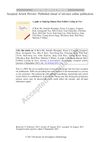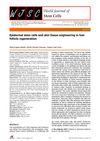TLDR Stem cell treatments show promise for treating hair loss.
In recent years, regenerative treatments in dermatology gained importance, particularly for hair diseases, which were common complaints in dermatology clinics. Promising results from stem cell treatments for hair loss attracted attention. Mesenchymal stem cells, derived from various tissues, were used due to their multipotent nature and ability to differentiate into various cell types. These stem cells could be sourced from fetal cells (umbilical cord and amniotic sac) or adult cells (teeth, bone marrow, or adipose tissue). Adipose tissue-derived mesenchymal stem cells, obtained from white and brown fat tissue, were preferred for their cost-effectiveness and unlimited cell availability. These cells, also fibroblast and keratinocyte stem cells, played a crucial role in secreting growth factors and transforming into different cell types. Advances in the cellular and molecular biology of hair and skin led to the initiation of cell therapy in this field, with hair stem cells offering new hope for treating hair diseases. Hair follicles served as the primary source of multipotent stem cells in the skin, with the potential to renew the skin and restore hair follicles. The study aimed to discuss the use of stem cell therapies in treating hair diseases.
 86 citations
,
June 2017 in “Stem cell investigation”
86 citations
,
June 2017 in “Stem cell investigation” Stem cells from hair follicles can safely treat hair loss.
 55 citations
,
May 2017 in “Current stem cell research & therapy”
55 citations
,
May 2017 in “Current stem cell research & therapy” Using fat-derived stem cells for hair loss treatment is safe and effective, improving hair growth and patient satisfaction.
 19 citations
,
January 2017 in “Stem Cells International”
19 citations
,
January 2017 in “Stem Cells International” Adipose-derived stem cells show promise in treating skin conditions like vitiligo, alopecia, and nonhealing wounds.
 9 citations
,
January 2016 in “PubMed”
9 citations
,
January 2016 in “PubMed” Stem cell therapy could be a promising alternative for hair regrowth with fewer side effects.
 232 citations
,
October 2015 in “International journal of molecular sciences”
232 citations
,
October 2015 in “International journal of molecular sciences” Stem cells are crucial for skin repair and new treatments for chronic wounds.
 212 citations
,
September 2015 in “Journal of Investigative Dermatology”
212 citations
,
September 2015 in “Journal of Investigative Dermatology” The document provides a method to classify human hair growth stages using a model with human scalp on mice, aiming to standardize hair research.
55 citations
,
April 2015 in “BMC medicine” Stem Cell Educator therapy helps regrow hair and improve life quality in alopecia areata patients.
 83 citations
,
January 2015 in “World Journal of Stem Cells”
83 citations
,
January 2015 in “World Journal of Stem Cells” Hair follicle regeneration needs special conditions and young cells.
 61 citations
,
June 2014 in “Scientific Reports”
61 citations
,
June 2014 in “Scientific Reports” Wnt1a-conditioned medium from stem cells helps activate cells important for hair growth and can promote hair regrowth.
 499 citations
,
September 2011 in “Cell”
499 citations
,
September 2011 in “Cell” Fat-related cells are important for initiating hair growth.
 September 2023 in “Frontiers in medicine”
September 2023 in “Frontiers in medicine” The mTOR signaling pathway is crucial for hair health and targeting it may lead to new hair loss treatments.
 February 2025 in “Stem Cell Research & Therapy”
February 2025 in “Stem Cell Research & Therapy” Maintaining healthy mitochondria may help treat hair loss.
June 2024 in “Regenerative Therapy” Exosomes from stem cells may help rejuvenate skin and regrow hair, but more research is needed.
 1 citations
,
July 2019 in “Journal of Dermatology and Dermatologic Surgery”
1 citations
,
July 2019 in “Journal of Dermatology and Dermatologic Surgery” Stem cell therapy shows promise for hair loss treatment, but more research is needed to confirm its effectiveness.
 September 2025 in “Cosmoderma”
September 2025 in “Cosmoderma” Pandemic stress worsens hair loss and skin issues, suggesting combined mental and skin care treatments.














